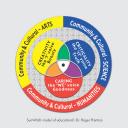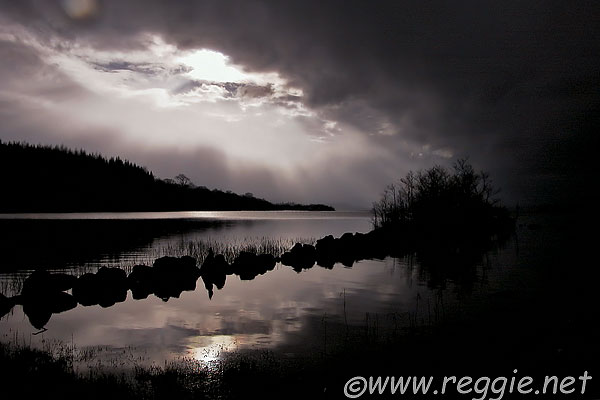
My personal myth Island, Shoreline and Ocean –
a view of story in Personal Development and in Holistic Education
Introduction:
By way of an introduction here are a few succinct thoughts. Skip this if you want to go straight to my ‘personal myth’;
Myth operates in us – its part of being human – like philosophizing. Therefore we should make the most of it – in terms of the mythology we make, and that with which we choose to identify.
Story is central to our meaning-making and how we (choose) to make sense of the world and give account of our encounters and experiences.
Myth, as opposed to story generally, is about our deepest concerns and is characterized as narrative that gives account of the unknown and unknowable as well as some of the known. E.g. we die but we don’t know what, if anything, happens after that. Myth creates and is derived from beliefs.
Myth intrapersonally is the clothing we give to the psycho-spiritual dynamics of inner experience.
Myth interpersonally is the stories we tell each other to explain encounters with the (mainly) unknown and unknowable.
Karen Armstrong’s A Short History of Myth is a must because it makes clear the relationship between myth and religion and world-views.
“Without myth, cult, ritual and ethical living, a sense of the sacred dies,” says Armstrong. Without the discipline of mythical thinking and practice, it was difficult for many to avoid despair. The dark epiphanies of the 20th century can be blamed on “the absence of a viable mythology” that could help us face the unspeakable. Guardian review by Tim Radford
A personal myth operates in us whether we choose to articulate it or not. It is closely allied to what one psychologist called ‘our personal script’ and the another (Kelly) called our set of ‘personal constructs’.
We can help in healing ourselves by articulating our personal myth in comparison and contrast to the group myths around us – or that exist as historical artifacts.
Restorying, (e.g.by writing different versions of) our personal myth can enable us to re-frame our personal experience and gain degrees of control and depths of energy that previously were denied us through locked-up pain.
Creating a personal myth can facilitate better self-understanding and there is potentially a powerful tool for teaching and learning.
My personal myth is here;
The ‘Island, Shoreline and Ocean’ personal Myth
The personal myth that follows was written as a ‘one-page’ way of expressing a) a sense of the relationship with the cosmos, the Whole, and b) of a range of the ideas in, and behind, SunWALK. Jane is part of me, perhaps the same Jane as in Jane’s Short Story in Chapter 1.
The personal myth is an attempt at re-storying one kind of knowing. A felt need to undertake a re-storying of knowing can lie in acknowledgement of the fact that we know, and need to know, and need to express that knowing, in more ways than the empirical-reasoning mode – hence Island, Shoreline, Ocean. To admit other ways of knowing, is to admit that in our wholeness we are more than our senses and our reasoning. It is also to admit that in our knowing we are surrounded by mystery, which we encounter. We in various ways give accounts of those encounters.
3:3 Island, Shoreline and Ocean
a personal myth concerning the nature of mystical experience & its relationship to consciousness, & to knowledge creation – as such it is an attempt to include as much as possible of what I learned during the eleven year journey of the thesis – in a ‘one page’ story
The sun always woke her. Every day Jane walked through her garden, inspecting this plant and that, analysing what needed to be done. The quest was never-ending. Sometimes she sat a while on an old tree stump in order to consider the tasks and challenges, trying to work out the feelings and puzzles of what didn’t seem quite right, what didn’t feel quite right. What she couldn’t physically arrange she sometimes tried to paint or write – she had an imaginary garden as well as a real one. Sometimes she looked at her neighbours’ gardens, wondering if that would give her inspiration, but she was always left with the feeling that her most important answers came from elsewhere.
Every day beneath the practical considerations she felt a longing. Having made her review of her garden Jane walked over the fields, across the two streams that eventually made their way down to the sea, and along the cliff, and down to the shoreline. At the shoreline she breathed in her sense of the infinity of the ocean, along with the ozone-heavy, sea-weedy, sea air.
Frequently she imagined the island’s shoreline around the island’s circumference. In her mind’s eye she saw each place being shaped in some different way by the ocean – which was sometimes gentle, and was sometimes awesome in its relentless might. Sometimes the feelings that filled her were so powerful that she was overcome. Sometimes the beauty of being in the presence of the ocean was so great that she felt that neither garden nor painting nor poetry would ever fully satisfy the deepest longing.
Often after such reverie she slipped into the sea.
The sea had so much salt that she just floated. And, when the temperature was right, in floating, eyes closed, she lost all sense of where she ended and where the surrounding sea began. There was no separate sea, no separate self – it was just ….. being. It was always that way, just being. At such times she felt both full and empty, both powerless and at that same time she felt herself to be the very ocean that insistently carved and re-carved the island shoreline.
Mostly at that point she just wanted to stay, to be just part of this place between land and sea, like a driftwood sculpture, ocean-polished, that had been thrown up after a long journey from some river bank, high up some vaguely-remembered river. The shoreline was exquisitely the best of places. But she always took that first step. A first step on the walk back to her garden. And with the walking the experience that was ineffable started to give up insights and possibilities to both refine the garden, and to extend it into some more of the island’s familiar, wilderness, space.
In the evenings she and her friends sat beneath the moon, in whichever was the most interesting of their gardens, at that particular time, and they discussed the issues that concerned them. They all, more or less, had similar such deep experiences as Jane. The ongoing conversation was what united them, along with their respect for how they clothed so differently, in imagination and form, the experiences that were ineffable.
C. from an unpublished doctoral thesis by Roger Prentice, Northumberland ver July 2003
—–0—–
Karen Armstrong’s book A Short History of Myth is HERE NB Read the Customer Reviews which are excellent and ignore the Editorial Reviews which are carping, mean-spirited and self-serving!
Relevant book that looks interesting Restorying Our Lives: Personal Growth Through Autobiographical Reflection HERE
Island map SOURCE
—–0—–
All postings to this site relate to the central model in the PhD. Summaries are HERE
 Click on thumbnail – the diagram that pulls everything together.
Click on thumbnail – the diagram that pulls everything together.


 Source
Source Source Wiki on Meditation
Source Wiki on Meditation

